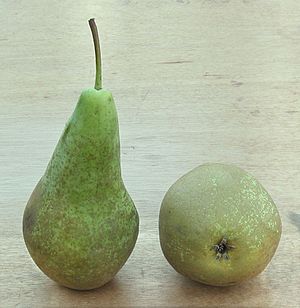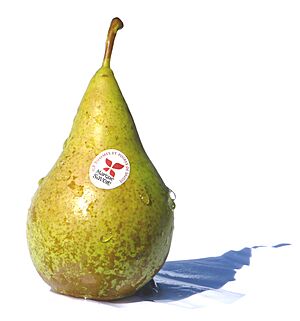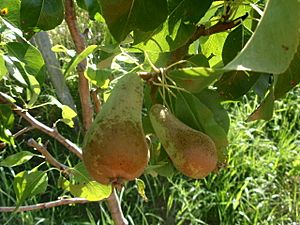Conference pear facts for kids
Quick facts for kids Conference pear |
|
|---|---|

Conference pear
|
|
| Genus | Pyrus |
| Species | Pyrus communis |
| Cultivar | 'Conference' |
| Breeder | Thomas Rivers |
| Origin | Britain |
The Conference pear is a very popular type of pear. It's an autumn variety of the European pear (Pyrus communis). This pear was first grown in Britain by Thomas Francis Rivers at his nursery in Sawbridgeworth, Hertfordshire. It got its name because it won first prize at a big pear meeting in London in 1885.
What Does a Conference Pear Look Like?

The Conference pear is a medium-sized pear. It has a long, bottle-like shape, a bit like the 'Bosc pear'. It's a great pear to eat fresh, either by itself or cut up.
The skin of a Conference pear is usually thick and greenish-brown. When the pear is fully ripe, its skin turns a pale yellow. The inside of the pear is white, but it also turns pale yellow when it's ripe. This pear has a very fine and soft texture, and it tastes sweet.
Sometimes, you might see brown patches on the skin. This is called "russet" or "russetting." It's a natural part of the pear's skin and how much you see depends on the weather conditions while it was growing.
Where Do Conference Pears Grow?
Conference pears can grow well in many different places. They are very popular in Europe. These pears grow best in sunny areas with rich soil that isn't too chalky.
In France, many Conference pears are grown in the north, like in Loire and Picardy. They also grow in the Alps, in places like Savoie. You can find them growing for sale in many parts of the United Kingdom too.
For a better harvest, it helps to have other pear varieties nearby. These other pears, like the Williams pear, help with pollination. This means they help the Conference pear trees produce more fruit.
Conference pears are quite strong and can resist diseases well, especially one called scab. If you keep them cool in a fridge or a well-aired cellar, you can enjoy Conference pears until January!
There's a lot of competition in Europe for selling Conference pears. Countries like the Netherlands, Belgium, Spain, and Italy also grow and sell many of them.
In 1996, the special taste of Conference pears grown in Savoie was officially recognized. They received a PGI, which stands for "Protected Geographical Indication." This means that only pears grown in that specific area can be called "Conference pears from Savoie." As of 2012, it was the only pear in France to have this special recognition.
See also
 In Spanish: Conference (pera) para niños
In Spanish: Conference (pera) para niños


